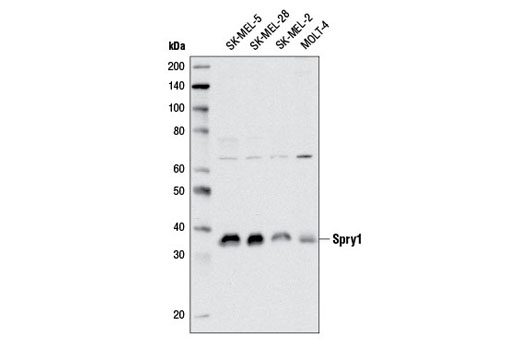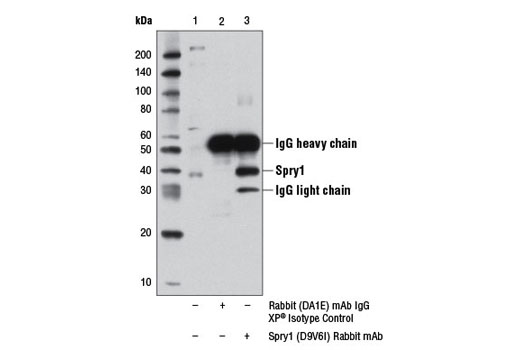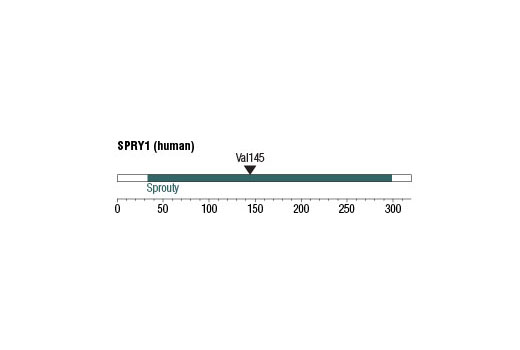WB, IP
H M
Endogenous
35
Rabbit IgG
#O43609
10252
Product Information
Product Usage Information
| Application | Dilution |
|---|---|
| Western Blotting | 1:1000 |
| Immunoprecipitation | 1:100 |
Storage
Specificity / Sensitivity
Species Reactivity:
Human, Mouse
Source / Purification
Monoclonal antibody is produced by immunizing animals with a synthetic peptide corresponding to residues surrounding Val145 of human Spry1 protein.
Background
Spry1 is a member of the Sprouty (Spry) family proteins that was initially identified in Drosophila as an inhibitor of the FGF signaling pathway (1). There are four human Spry proteins (Spry1-4), encoded by different genes, and they all share a highly conserved carboxy-terminal cystine-rich Spry domain that is known to be essential for their receptor tyrosine kinase inhibitory function stimulated by various growth factors (1-3). Spry1 and other Spry proteins play a key role in embryonic development, tissue and organ formation, as well as growth in almost all living organisms (1-4). Spry proteins are considered tumor suppressors due to their inhibitory function in a variety of growth factor signaling pathways (2,3). Spry1 anchors itself to the membrane by palmitoylation and can translocate from the cytosol to the membrane by binding to caveolin-1 (5,6). Regulation of Spry1 protein function is thought to occur at various levels. Spry1 regulation includes transcriptional regulation by growth factors and kinases (1,4,7), post-transcriptional regulation by microRNA-21 (8), post-translational modifications including phosphorylation, dephosphorylation, ubiquitination and proteasomal degradation, and regulation by its interacting protein partners (2,3).
- Hacohen, N. et al. (1998) Cell 92, 253-63.
- Edwin, F. et al. (2009) Mol Pharmacol 76, 679-91.
- Guy, G.R. et al. (2009) J Endocrinol 203, 191-202.
- Minowada, G. et al. (1999) Development 126, 4465-75.
- Impagnatiello, M.A. et al. (2001) J Cell Biol 152, 1087-98.
- Hanafusa, H. et al. (2002) Nat Cell Biol 4, 850-8.
- Ozaki, K. et al. (2001) Biochem Biophys Res Commun 285, 1084-8.
- Thum, T. et al. (2008) Nature 456, 980-4.
Species Reactivity
Species reactivity is determined by testing in at least one approved application (e.g., western blot).
Western Blot Buffer
IMPORTANT: For western blots, incubate membrane with diluted primary antibody in 5% w/v nonfat dry milk, 1X TBS, 0.1% Tween® 20 at 4°C with gentle shaking, overnight.
Applications Key
WB: Western Blotting IP: Immunoprecipitation
Cross-Reactivity Key
H: human M: mouse R: rat Hm: hamster Mk: monkey Vir: virus Mi: mink C: chicken Dm: D. melanogaster X: Xenopus Z: zebrafish B: bovine Dg: dog Pg: pig Sc: S. cerevisiae Ce: C. elegans Hr: horse GP: Guinea Pig Rab: rabbit All: all species expected
Trademarks and Patents
Limited Uses
Except as otherwise expressly agreed in a writing signed by a legally authorized representative of CST, the following terms apply to Products provided by CST, its affiliates or its distributors. Any Customer's terms and conditions that are in addition to, or different from, those contained herein, unless separately accepted in writing by a legally authorized representative of CST, are rejected and are of no force or effect.
Products are labeled with For Research Use Only or a similar labeling statement and have not been approved, cleared, or licensed by the FDA or other regulatory foreign or domestic entity, for any purpose. Customer shall not use any Product for any diagnostic or therapeutic purpose, or otherwise in any manner that conflicts with its labeling statement. Products sold or licensed by CST are provided for Customer as the end-user and solely for research and development uses. Any use of Product for diagnostic, prophylactic or therapeutic purposes, or any purchase of Product for resale (alone or as a component) or other commercial purpose, requires a separate license from CST. Customer shall (a) not sell, license, loan, donate or otherwise transfer or make available any Product to any third party, whether alone or in combination with other materials, or use the Products to manufacture any commercial products, (b) not copy, modify, reverse engineer, decompile, disassemble or otherwise attempt to discover the underlying structure or technology of the Products, or use the Products for the purpose of developing any products or services that would compete with CST products or services, (c) not alter or remove from the Products any trademarks, trade names, logos, patent or copyright notices or markings, (d) use the Products solely in accordance with CST Product Terms of Sale and any applicable documentation, and (e) comply with any license, terms of service or similar agreement with respect to any third party products or services used by Customer in connection with the Products.


